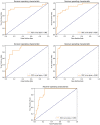Prediction of pathological complete response to neoadjuvant chemotherapy in locally advanced breast cancer by using a deep learning model with 18F-FDG PET/CT
- PMID: 37708209
- PMCID: PMC10501592
- DOI: 10.1371/journal.pone.0290543
Prediction of pathological complete response to neoadjuvant chemotherapy in locally advanced breast cancer by using a deep learning model with 18F-FDG PET/CT
Abstract
Objectives: The aim of the study is 18F-FDG PET/CT imaging by using deep learning method are predictive for pathological complete response pCR after Neoadjuvant chemotherapy (NAC) in locally advanced breast cancer (LABC).
Introduction: NAC is the standard treatment for locally advanced breast cancer (LABC). Pathological complete response (pCR) after NAC is considered a good predictor of disease-free survival (DFS) and overall survival (OS).Therefore, there is a need to develop methods that can predict the pCR at the time of diagnosis.
Methods: This article was designed as a retrospective chart study.For the convolutional neural network model, a total of 355 PET/CT images of 31 patients were used. All patients had primary breast surgery after completing NAC.
Results: Pathological complete response was obtained in a total of 9 patients. The study results show that our proposed deep convolutional neural networks model achieved a remarkable success with an accuracy of 84.79% to predict pathological complete response.
Conclusion: It was concluded that deep learning methods can predict breast cancer treatment.
Copyright: © 2023 Bulut et al. This is an open access article distributed under the terms of the Creative Commons Attribution License, which permits unrestricted use, distribution, and reproduction in any medium, provided the original author and source are credited.
Conflict of interest statement
The authors have declared that no competing interests exist.
Figures





Similar articles
-
The Value of 18F-FDG PET/CT Imaging Combined With Pretherapeutic Ki67 for Early Prediction of Pathologic Response After Neoadjuvant Chemotherapy in Locally Advanced Breast Cancer.Medicine (Baltimore). 2016 Feb;95(8):e2914. doi: 10.1097/MD.0000000000002914. Medicine (Baltimore). 2016. PMID: 26937935 Free PMC article.
-
18F-fluorodeoxyglucose (FDG) PET/CT after two cycles of neoadjuvant therapy may predict response in HER2-negative, but not in HER2-positive breast cancer.Oncotarget. 2015 Oct 6;6(30):29388-95. doi: 10.18632/oncotarget.5001. Oncotarget. 2015. PMID: 26336821 Free PMC article.
-
Prognostic Role of Early and End-of-Neoadjuvant Treatment 18F-FDG PET/CT in Patients With Breast Cancer.Clin Nucl Med. 2016 Jul;41(7):e313-22. doi: 10.1097/RLU.0000000000001191. Clin Nucl Med. 2016. PMID: 26953659
-
¹⁸F-FDG PET/CT in the early prediction of pathological response in aggressive subtypes of breast cancer: review of the literature and recommendations for use in clinical trials.Eur J Nucl Med Mol Imaging. 2016 May;43(5):983-993. doi: 10.1007/s00259-015-3295-z. Epub 2016 Jan 13. Eur J Nucl Med Mol Imaging. 2016. PMID: 26758726 Review.
-
Prognostic value of 18F-FDG PET and PET/CT for assessment of treatment response to neoadjuvant chemotherapy in breast cancer: a systematic review and meta-analysis.Breast Cancer Res. 2020 Oct 31;22(1):119. doi: 10.1186/s13058-020-01350-2. Breast Cancer Res. 2020. PMID: 33129348 Free PMC article.
Cited by
-
Multimodal deep learning for predicting neoadjuvant treatment outcomes in breast cancer: a systematic review.Biol Direct. 2025 Jun 23;20(1):72. doi: 10.1186/s13062-025-00661-8. Biol Direct. 2025. PMID: 40551237 Free PMC article.
-
Dendritic Cell Subpopulations Are Associated with Prognostic Characteristics of Breast Cancer after Neoadjuvant Chemotherapy-An Observational Study.Int J Mol Sci. 2023 Oct 31;24(21):15817. doi: 10.3390/ijms242115817. Int J Mol Sci. 2023. PMID: 37958800 Free PMC article.
-
FDG-PET/CT and Multimodal Machine Learning Model Prediction of Pathological Complete Response to Neoadjuvant Chemotherapy in Triple-Negative Breast Cancer.Cancers (Basel). 2025 Apr 7;17(7):1249. doi: 10.3390/cancers17071249. Cancers (Basel). 2025. PMID: 40227836 Free PMC article.
References
MeSH terms
Substances
LinkOut - more resources
Full Text Sources
Medical

